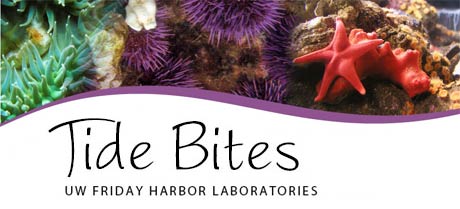Friday Harbor Labs Tide Bites
Posted December 19, 2020 at 4:30 am by Hayley Day
Students Study Kelp Consumers
By Katie Dobkowski, James Calhoon, Katrina Johnson and Muriel Dittrich
Katie Dobkowski is a visiting assistant professor at Bates College in Lewiston, Maine, and a mentor in the Friday Harbor summer REU program. She earned her Ph.D. from the University of Washington in 2017 and has conducted research at the labs since taking the Marine Algae course in Summer 2010. She received funding from the Bates Faculty Development Fund and the Friday Harbor Labs Dudley Fellowship.
James Calhoon is a senior at Bates College studying Biology and Economics; he likes to surf and play guitar. James spent this past summer at the labs researching the feeding preferences of urchins. He received funding from the Bates Environmental Internship and Bates Student Research Fund and from the labs’ REU program.
Katrina Johnson is a senior at Bates College, studying Biology and Chemistry, who spent the summer of 2020 at the labs and has a profound love of orcas. She received funds from the Bates Hoffman Fellowship and the labs’ REU program.
Muriel Dittrich is a senior at the University of Alaska Southeast studying Marine Biology. Muriel was an REU at the labs during the summer of 2020 and she likes to go crabbing and explore kelp forests.
We were very fortunate to be able to travel to Friday Harbor Labs to conduct research during the summer of 2020 in spite of the COVID-19 pandemic and are exceedingly grateful to all of the Friday Harbor Labs faculty (including the REU program coordinators, Stacy Farina and Adam Summers) and staff who made this opportunity possible.
The four of us quarantined for two weeks, got COVID tests, and then formed a summer research “pod,” with the students sharing a cottage (and sometimes cooking duties!) while living and working at FHL. When they were not in the lab or out snorkeling, Katie introduced the rest of her pod to the delights of takeout from San Juan Island bakeries.
Bull kelp (Nereocystis luetkeana) is a major primary producer and crucial habitat for other economically and ecologically important species.
Its distribution and abundance are changing in some parts of the Salish Sea as well as other parts of its broad range, from Alaska to central California.
While multiple factors might cause these shifts, effects of herbivory and of competition from a non-native (but often increasingly abundant) species of seaweed (wireweed, Sargassum muticum) may be contributing factors.
In our summer research, we investigated relationships between native bull kelp (N. luetkeana), non-native wireweed (S. muticum), and a variety of herbivores. Our pod used a combination of laboratory experiments and field surveys (via snorkel!) to begin to understand the ecological relevance of interactions between and among these species in our region of the Salish Sea.
You can support the San Juan Update by doing business with our loyal advertisers, and by making a one-time contribution or a recurring donation.











No comments yet. Be the first!
By submitting a comment you grant the San Juan Update a perpetual license to reproduce your words and name/web site in attribution. Inappropriate, irrelevant and contentious comments may not be published at an admin's discretion. Your email is used for verification purposes only, it will never be shared.